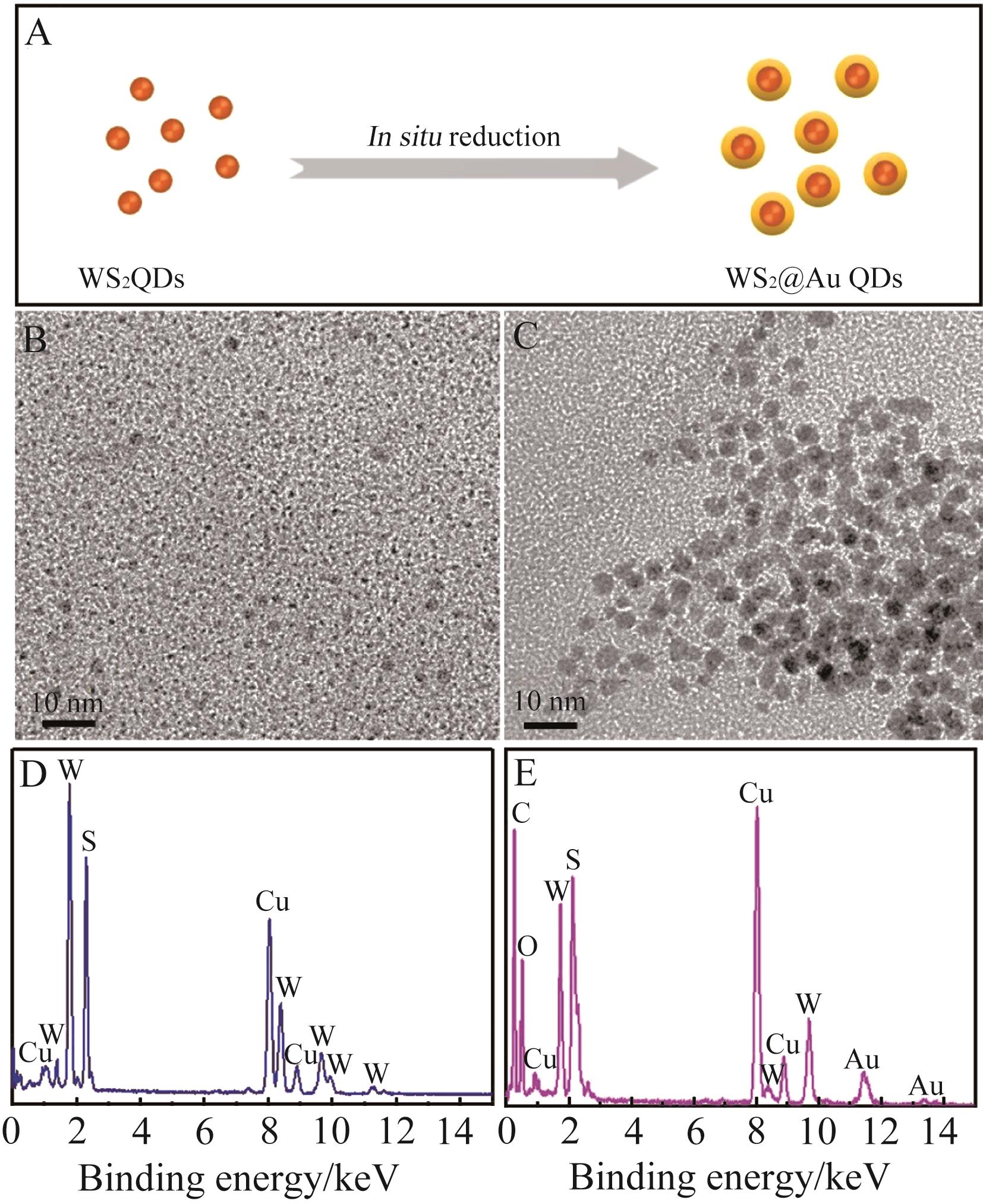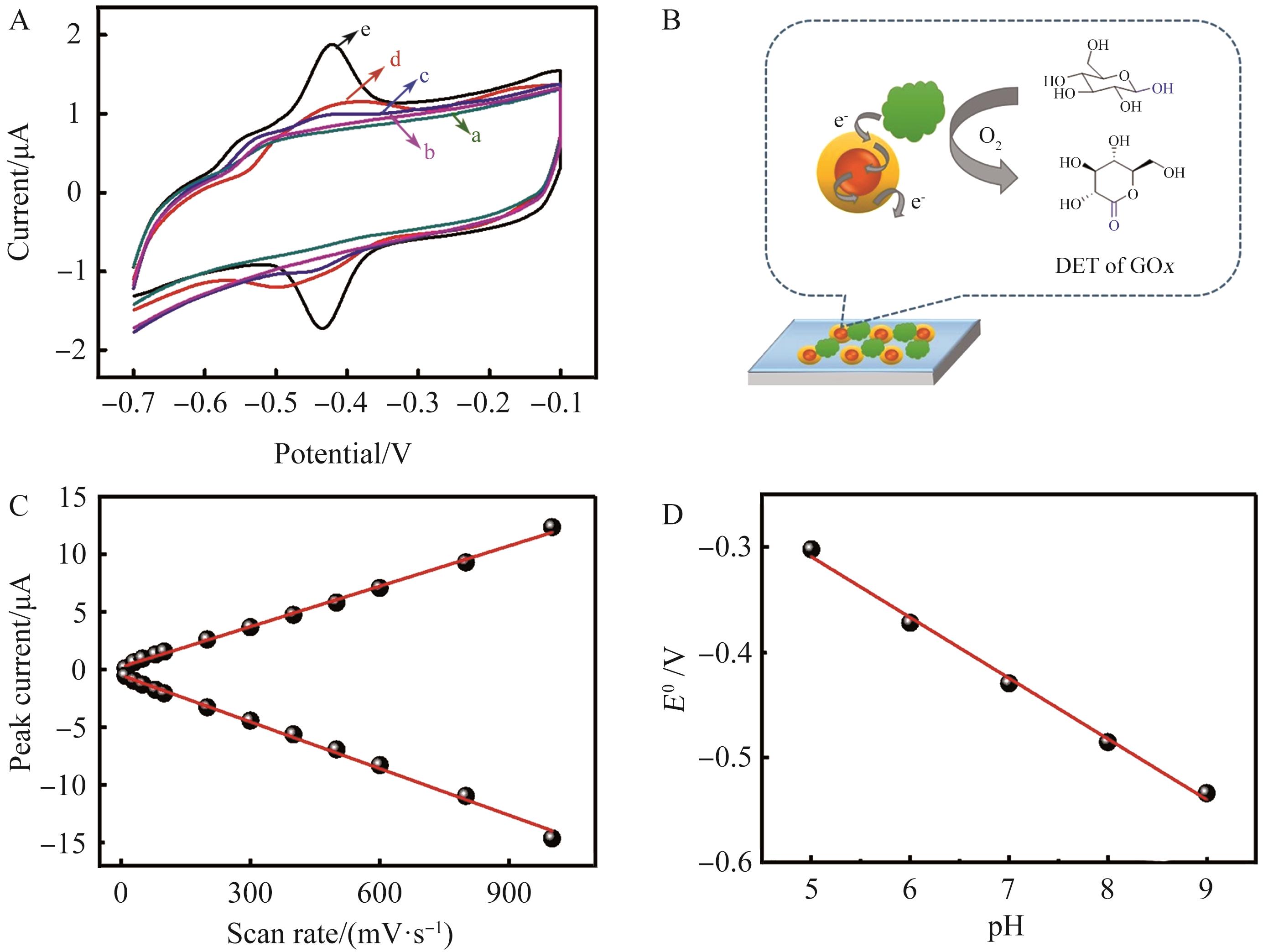| 1 |
HU Y L, HUANG Y, TAN C L, et al. Two-dimensional transition metal dichalcogenide nanomaterials for biosensing applications[J]. Mate Chem Front, 2017, 1(1): 24-36.
|
| 2 |
YANG G H, ZHU C Z, DU D, et al. Graphene-like two-dimensional layered nanomaterials: applications in biosensors and nanomedicine[J]. Nanoscale, 2015, 7(34): 14217-14231.
|
| 3 |
MONGA D, SHARMA S, SHETTI N P, et al. Advances in transition metal dichalcogenide-based two-dimensional nanomaterials[J]. Mater Today Chem, 2021, 19: 100399.
|
| 4 |
LIN T R, ZHONG L S, SONG Z P, et al. Visual detection of blood glucose based on peroxidase-like activity of WS2 nanosheets[J]. Biosens Bioelectron, 2014, 62: 302-307.
|
| 5 |
CHEN Q, CHEN J, GAO C J, et al. Hemin-functionalized WS2 nanosheets as highly active peroxidase mimetics for label-free colorimetric detection of H2O2 and glucose[J]. Analyst, 2015, 140(8): 2857-2863.
|
| 6 |
ROHAIZAD N, MAYORGA-MARTINEZ C C, SOFER Z, et al. 1T-Phase transition metal dichalcogenides (MoS2, MoSe2, WS2, and WSe2) with fast heterogeneous electron transfer: application on second-generation enzyme-based biosensor[J]. ACS Appl Mater Interfaces, 2017, 9(46): 40697-40706.
|
| 7 |
ZHOU L Y, YAN S C, WU H, et al. Facile sonication synthesis of WS2 quantum dots for photoelectrochemical performance[J]. Catalysts, 2017, 7(1) : 18.
|
| 8 |
ZHANG K Y, FU L, ZHANG W L, et al. Ultrasmall and monolayered tungsten dichalcogenide quantum dots with giant spin-valley coupling and purple luminescence[J]. ACS Omega, 2018, 3(9): 12188-12194.
|
| 9 |
BAI Y F, XU T B, LUONG J H T, et al. Direct electron transfer of glucose oxidase-boron doped diamond interface: a new solution for a classical problem[J]. Anal Chem, 2014, 86(10): 4910-4918.
|
| 10 |
NIRALA VINITA N R, PRAKASH R. One step synthesis of AuNPs@MoS2-QDs composite as a robust peroxidase- mimetic for instant unaided eye detection of glucose in serum, saliva and tear[J]. Sens Actuators B, 2018, 263: 109-119.
|
| 11 |
POLYAKOV A Y, YADGAROV L, POPOVITZ-BIRO R, et al. Decoration of WS2 nanotubes and fullerene-like MoS2 with gold nanoparticles[J]. J Phys Chem C, 2014, 118(4): 2161-2169.
|
| 12 |
SU S, ZHANG C, YUWEN L H, et al. Creating SERS hot spots on MoS2 nanosheets with in situ grown gold nanoparticles[J]. ACS Appl Mater Interfaces, 2014, 6(21): 18735-18741.
|
| 13 |
ZHANG M, ZHENG J, WANG J P, et al. Direct electrochemistry of cytochrome C immobilized on one dimensional Au nanoparticles functionalized magnetic N-doped carbon nanotubes and its application for the detection of H2O2[J]. Sens Actuators B, 2019, 282: 85-95.
|
| 14 |
MURPHY M, THEYAGARAJAN K, THENMOZHI K, et al. Direct electrochemistry of covalently immobilized hemoglobin on a naphthylimidazolium butyric acid ionic liquid/MWCNT matrix[J]. Colloid Surf B, 2021, 199: 111540.
|
| 15 |
NIU X L, XIE H, LUO G L, et al. Platinum-3D graphene oxide areogel nanocomposite for direct electrochemistry and electrocatalysis of horseradish peroxidase[J]. J Electrochem Soc, 2018, 165(14): B713-B719.
|
| 16 |
GENTIL S, CARRIÈRE M, COSNIER S, et al. Direct electrochemistry of bilirubin oxidase from magnaporthe orizae on covalently-functionalized MWCNT for the design of high-performance oxygen-reducing biocathodes[J]. Chem Eur J, 2018, 24(33): 8404-8408.
|
| 17 |
TAOTAO L, ZOU L, GUO X G, et al. Rising mesopores to realize direct electrochemistry of glucose oxidase toward highly sensitive detection of glucose[J]. Adv Funct Mater, 2019, 29(44): 1903026.
|
| 18 |
ZHANG K, ZHOU H, HU P, et al. The direct electrochemistry and bioelectrocatalysis of nitrate reductase at a gold nanoparticles/aminated graphene sheets modified glassy carbon electrode[J]. RSC Adv, 2019, 9: 37207-37213.
|
| 19 |
ZHANG D D, CHEN X, MA W N, et al. Direct electrochemistry of glucose oxidase based on one step electrodeposition of reduced graphene oxide incorporating polymerized L-lysine and its application in glucose sensing[J]. Mater Sci Eng C-Mater, 2019, 104: 109880.
|
| 20 |
KALIMUTHU P, BELAIDI A A, SCHWARZ G, et al. Chitosan-promoted direct electrochemistry of human sulfite oxidase[J]. J Phys Chem B, 2017, 121(39): 9149-9159.
|
| 21 |
CHEN H C, TU Y M, HOU C C, et al. Direct electron transfer of glucose oxidase and dual hydrogen peroxide and glucose detection based on water-dispersible carbon nanotubes derivative[J]. Anal Chim Acta, 2015, 867: 83-91.
|
| 22 |
YIN Z, JI Z, ZHANG W, et al. The glucose effect on direct electrochemistry and electron transfer reaction of glucose oxidase entrapped in a carbon nanotube-polymer matrix[J]. ChemistrySelect, 2020, 5(39): 12224-12231.
|
| 23 |
YANG Z J, CAO Y, LI J, et al. Platinum nanoparticles functionalized nitrogen doped graphene platform for sensitive electrochemical glucose biosensing[J]. Anal Chim Acta, 2015, 871: 35-42.
|
| 24 |
SAGLAM O, KIZILKAYA B, UYSAL H, et al. Biosensing of glucose in flow injection analysis system based on glucose oxidase-quantum dot modified pencil graphite electrode[J]. Talanta, 2016, 147: 315-321.
|
| 25 |
YUE Z, LISDAT F, PARAK W J, et al. Quantum-dot-based photoelectrochemical sensors for chemical and biological detection[J]. ACS Appl Mater Interfaces, 2013, 5(8): 2800-2814.
|
| 26 |
DU J, YU X P, DI J W. Comparison of the direct electrochemistry of glucose oxidase immobilized on the surface of Au, CdS and ZnS nanostructures[J]. Biosens Bioelectron, 2012, 37(1): 88-93.
|
| 27 |
ZHANG H F, MENG Z C, WANG Q, et al. A novel glucose biosensor based on direct electrochemistry of glucose oxidase incorporated in biomediated gold nanoparticles-carbon nanotubes composite film[J]. Sens Actuators B, 2011, 158(1): 23-27.
|
| 28 |
LIU J, HE Z M, KHOO S Y, et al. A new strategy for achieving vertically-erected and hierarchical TiO2 nanosheets array/carbon cloth as a binder-free electrode for protein impregnation, direct electrochemistry and mediator-free glucose sensing[J]. Biosens Bioelectron, 2016, 77: 942-949.
|
| 29 |
YANG Z J, TANG Y, LI J, et al. Facile synthesis of tetragonal columnar-shaped TiO2 nanorods for the construction of sensitive electrochemical glucose biosensor[J]. Biosens Bioelectron, 2014, 54: 528-533.
|
| 30 |
SUN W, GUO Y Q, JU X M, et al. Direct electrochemistry of hemoglobin on graphene and titanium dioxide nanorods composite modified electrode and its electrocatalysis[J]. Biosens Bioelectron, 2013, 42: 207-213.
|
| 31 |
WANG L X, BAI J, BO X J, et al. A novel glucose sensor based on ordered mesoporous carbon-Au nanoparticles nanocomposites[J]. Talanta, 2011, 83(5): 1386-1391.
|
| 32 |
WANG Y, NI Y N. Molybdenum disulfide quantum dots as a photoluminescence sensing platform for 2,4,6-trinitrophenol detection[J]. Anal Chem, 2014, 86(15): 7463-7470.
|
| 33 |
ZHOU X, DAI X X, LI J G, et al. A sensitive glucose biosensor based on Ag@C core-shell matrix[J]. Mater Sci Eng C-Mater, 2015, 49: 579-587.
|
| 34 |
LI J, YANG Z J, TANG Y, et al. Carbon nanotubes-nanoflake-like SnS2 nanocomposite for direct electrochemistry of glucose oxidase and glucose sensing[J]. Biosens Bioelectron, 2013, 41: 698-703.
|
| 35 |
PENG H P, LIANG R P, ZHANG L, et al. Facile preparation of novel core-shell enzyme-Au-polydopamine-Fe3O4 magnetic bionanoparticles for glucose sensor[J]. Biosens Bioelectron, 2013, 42: 293-299.
|
| 36 |
LIU S Q, JU H X. Reagentless glucose biosensor based on direct electron transfer of glucose oxidase immobilized on colloidal gold modified carbon paste electrode[J]. Biosens Bioelectron, 2003, 19(3): 177-183.
|
| 37 |
LAVIRON E. General expression of the linear potential sweep voltammogram in the case of diffusionless electrochemical systems[J]. J Electroanal Chem, 1979, 101(1): 19-28.
|
| 38 |
RAZMI H, MOHAMMAD-REZAEI R. Graphene quantum dots as a new substrate for immobilization and direct electrochemistry of glucose oxidase: application to sensitive glucose determination[J]. Biosens Bioelectron, 2013, 41: 498-504.
|
| 39 |
DENG C, CHEN J, CHEN X, et al. Direct electrochemistry of glucose oxidase and biosensing for glucose based on boron-doped carbon nanotubes modified electrode[J]. Biosens Bioelectron, 2008, 23(8): 1272-1277.
|
| 40 |
LUO X L, KILLARD A J, SMYTH M R. Reagentless glucose biosensor based on the direct electrochemistry of glucose oxidase on carbon nanotube-modified electrodes[J]. Electroanalysis, 2006, 18(11): 1131-1134.
|
| 41 |
PERIASAMY A P, CHANG Y J, CHEN S M, et al. Amperometric glucose sensor based on glucose oxidase immobilized on gelatin-multiwalled carbon nanotube modified glassy carbon electrode[J]. Bioelectrochemistry, 2011, 80(2): 114-120.
|
| 42 |
YANG Z J, TANG Y, LI J, et al. Facile synthesis of tetragonal columnar-shaped TiO2 nanorods for the construction of sensitive electrochemical glucose biosensor[J]. Biosens Bioelectron, 2014, 54: 528-533.
|
| 43 |
LI J, YANG Z, TANG Y, et al. Carbon nanotubes-nanoflake-like SnS2 nanocomposite for direct electrochemistry of glucose oxidase and glucose sensing[J]. Biosens Bioelectron, 2013, 41: 698-703.
|
| 44 |
PAKAPONGPAN S, POO-ARPORN R P. Self-assembly of glucose oxidase on reduced graphene oxide-magnetic nanoparticles nanocomposite-based direct electrochemistry for reagentless glucose biosensor[J]. Mater Sci Eng C-Mater, 2017, 76: 398-405.
|
| 45 |
HYUN K H, HAN S W, KOH W G, et al. Fabrication of biofuel cell containing enzyme catalyst immobilized by layer-by-layer method[J]. J Power Sources, 2015, 286: 197-203.
|
| 46 |
LIU J, HE Z, KHOO S Y, et al. A new strategy for achieving vertically-erected and hierarchical TiO2 nanosheets array/carbon cloth as a binder-free electrode for protein impregnation, direct electrochemistry and mediator-free glucose sensing[J]. Biosens Bioelectron, 2016, 77: 942-949.
|
| 47 |
SHAN C, YANG H, HAN D, et al. Graphene/AuNPs/chitosan nanocomposites film for glucose biosensing[J]. Biosens Bioelectron, 2010, 25(5): 1070-1074.
|
| 48 |
ZHANG X, LIU D, LI L, et al. Direct electrochemistry of glucose oxidase on novel free-standing nitrogen-doped carbon nanospheres@carbon nanofibers composite film[J]. Sci Rep-UK, 2015, 5: 9885.
|
| 49 |
LI J, TANG Y, YANG J, et al. Cage-like PbS nanostructure for the construction of novel glucose electrochemical biosensor[J]. Sens Actuators B, 2014, 190: 549-554.
|

 ), 李晴暖1(
), 李晴暖1( ), 孟祥英2(
), 孟祥英2( )
)
 ), Qing-Nuan LI1(
), Qing-Nuan LI1( ), Xiang-Ying MENG2(
), Xiang-Ying MENG2( )
)



